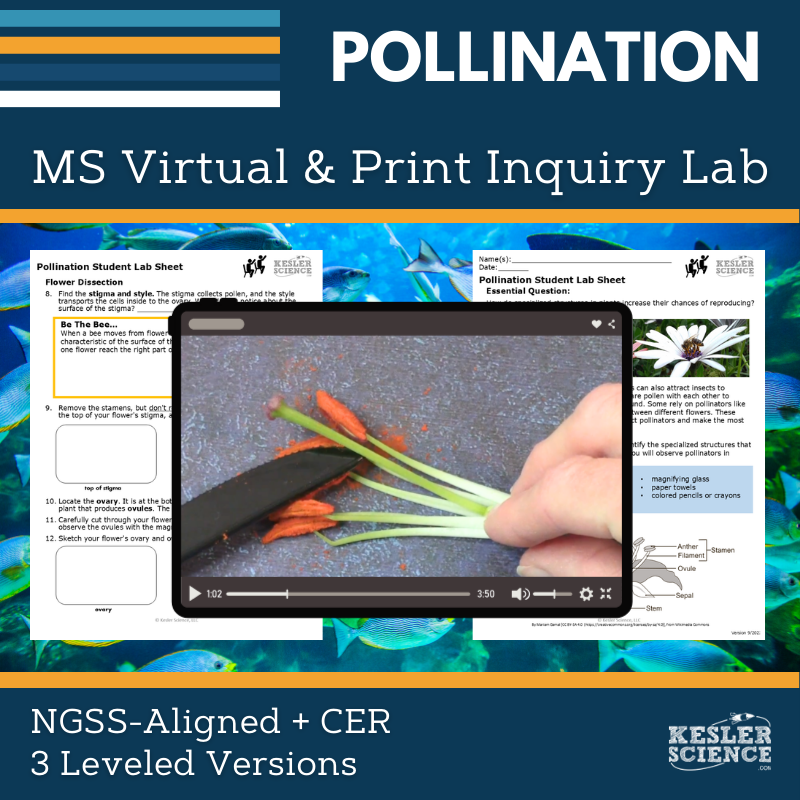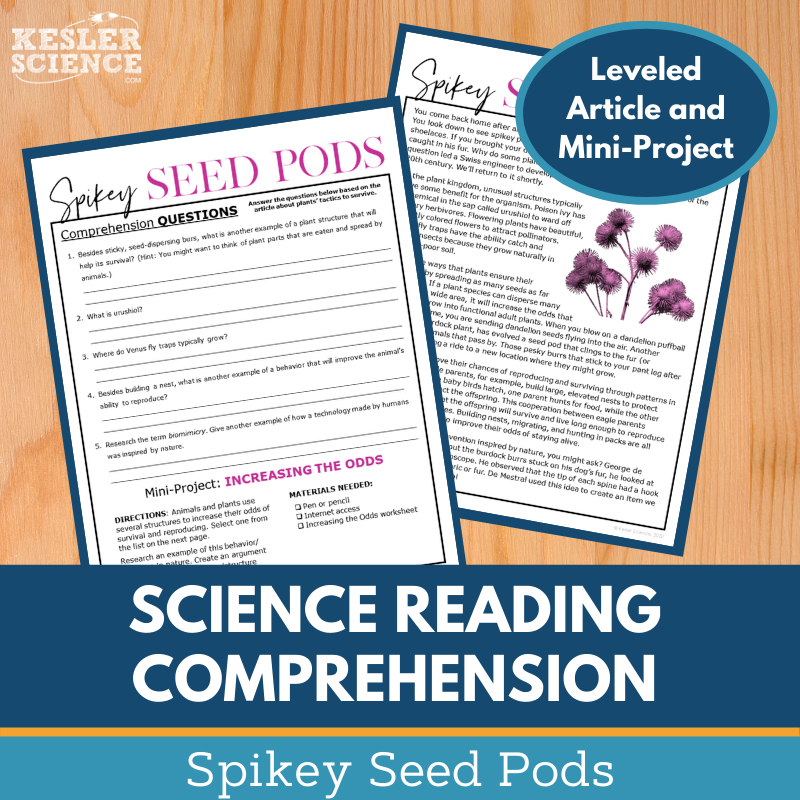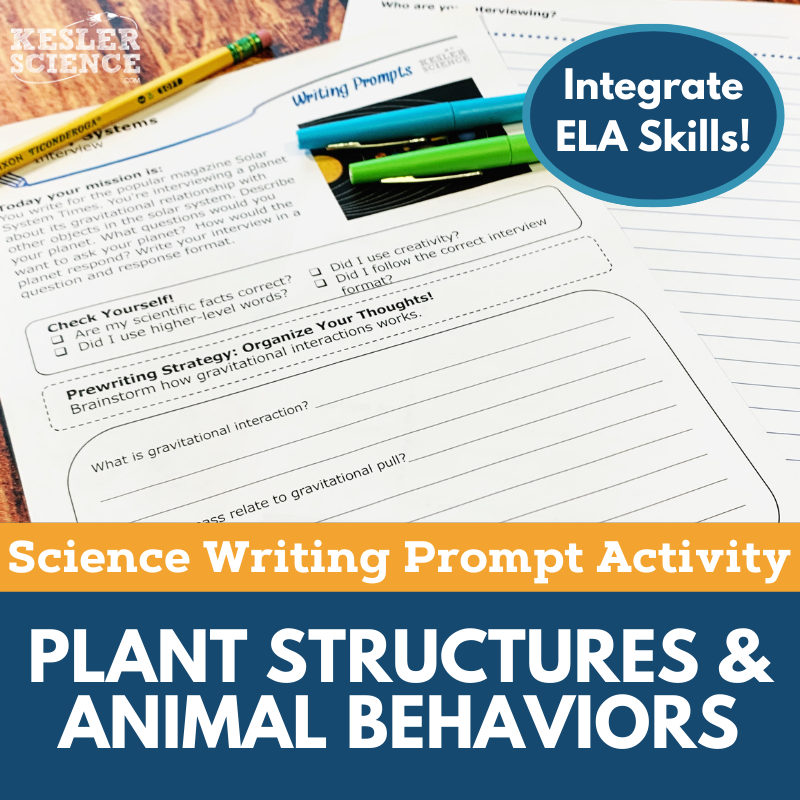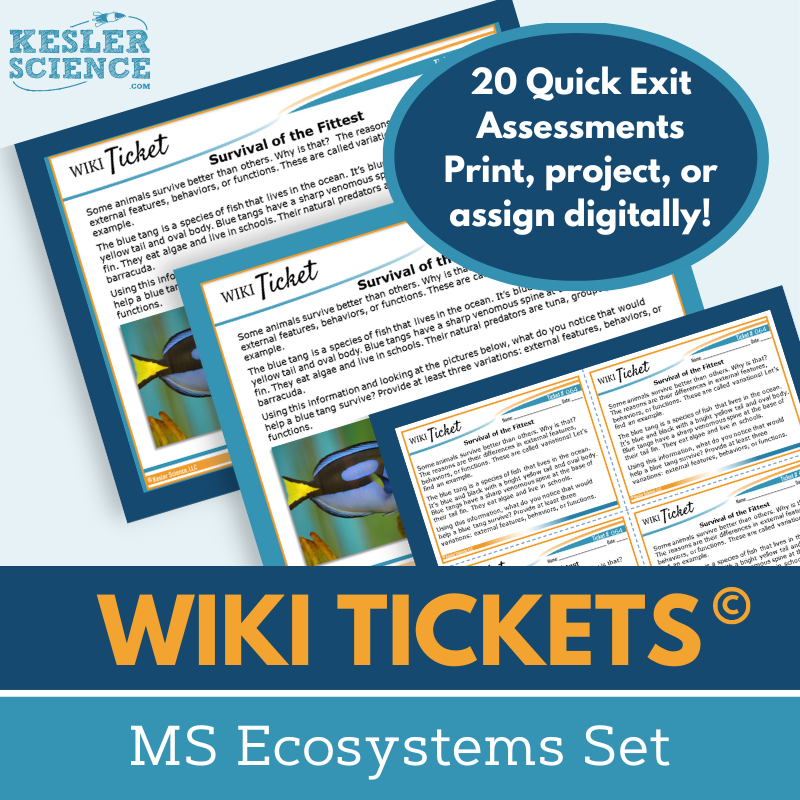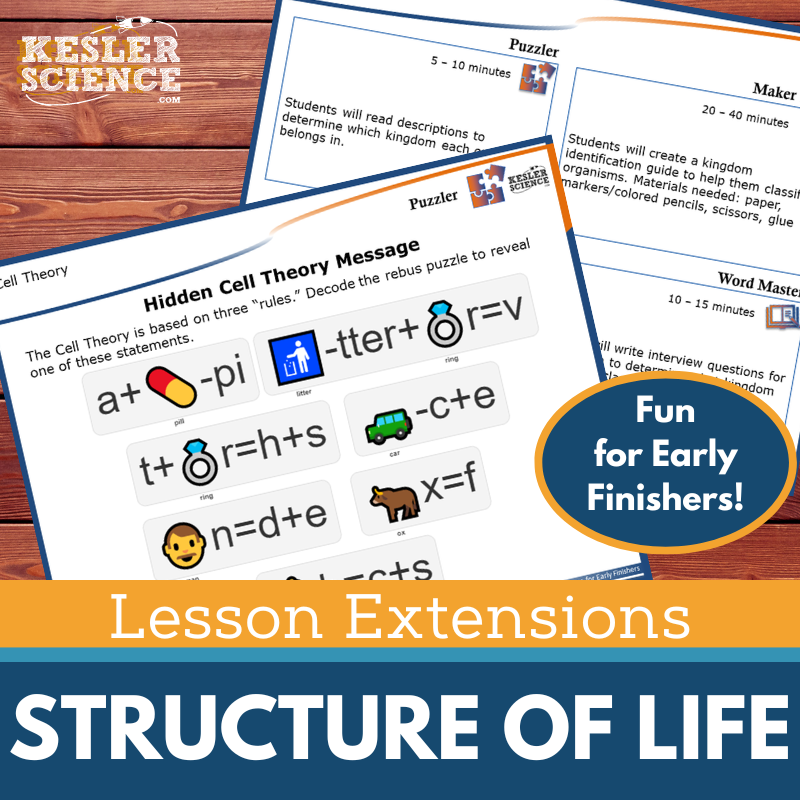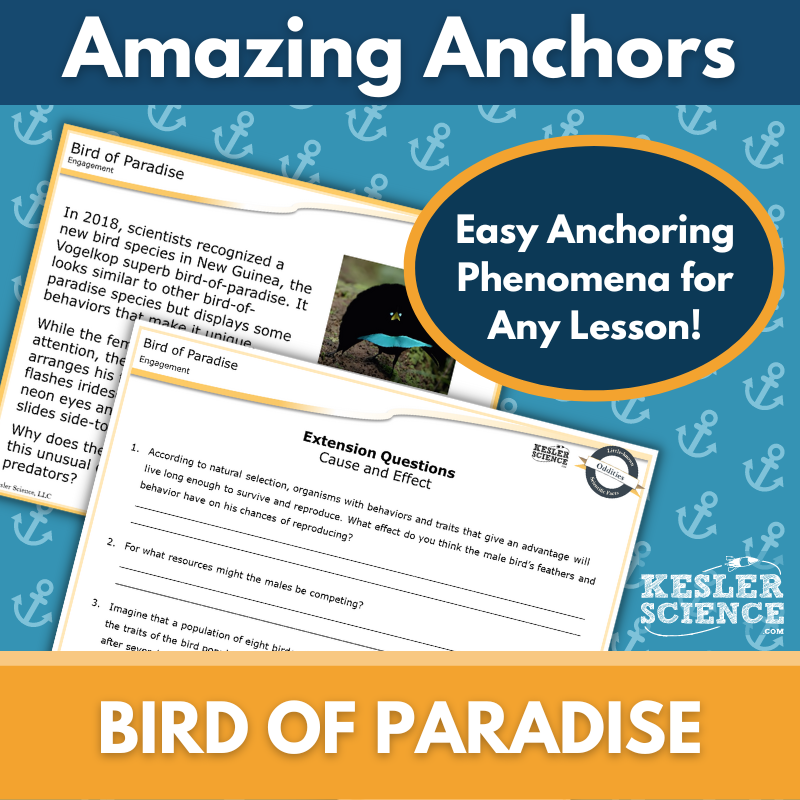Plant & Animal Reproduction Activities for Middle School Science
Students will explore how specialized plant structures enhance reproductive success with this engaging lesson. It features a Flower Dissection Inquiry Lab, aligned to NGSS MS-LS1-4. The resources below will give students a comprehensive understanding of plant and animal reproduction. All of the following materials are also included in the Kesler Science Membership.
The Flower Dissection Inquiry Lab aligns with NGSS MS-LS1-4, guiding students to explore how specialized plant structures enhance reproductive success. Students will dissect a flower to examine its reproductive structures and observe pollinators in action.
This lab includes both hands-on and digital formats, with comprehension questions, Claim-Evidence-Reasoning (C.E.R.) prompts, and a reflection section. The digital version features an interactive PowerPoint compatible with Google Slides, along with a pre-recorded demonstration for students who cannot complete the hands-on activity.
Three differentiated versions—dependent, modified, and independent—cater to various learning needs. The print version provides structured procedures for in-person lab work, while the digital version includes interactive activities requiring no materials. Editable files allow for customization, and teacher resource pages simplify implementation with answer keys, objectives, and instructional guidance.
The Flower Dissection Inquiry Lab aligns with NGSS MS-LS1-4, guiding students to explore how specialized plant structures enhance reproductive success. Students will dissect a flower to examine its reproductive structures and observe pollinators in action.
This lab includes both hands-on and digital formats, with comprehension questions, Claim-Evidence-Reasoning (C.E.R.) prompts, and a reflection section. The digital version features an interactive PowerPoint compatible with Google Slides, along with a pre-recorded demonstration for students who cannot complete the hands-on activity.
Three differentiated versions—dependent, modified, and independent—cater to various learning needs. The print version provides structured procedures for in-person lab work, while the digital version includes interactive activities requiring no materials. Editable files allow for customization, and teacher resource pages simplify implementation with answer keys, objectives, and instructional guidance.
This engaging lesson helps students explore how characteristic animal behaviors and specialized plant structures impact the probability of successful reproduction. Through a nonfiction article about spiky seed pods, students enhance their reading comprehension and science literacy.
Designed for middle school, this resource includes a leveled passage (Lexile 1100-1300), five to seven comprehension questions, and a hands-on mini-project where students research behaviors or structures that aid survival and reproduction. A Cornell notes template is provided for support.
Ideal for sub plans, ISS, extra credit, or whole-class instruction, this lesson fosters critical thinking and classroom discussions. It is compatible with virtual learning platforms like Google Classroom, MS Teams, Schoology, and Canvas, allowing students to respond directly in an interactive document.
This engaging lesson helps students explore how characteristic animal behaviors and specialized plant structures impact the probability of successful reproduction. Through a nonfiction article about spiky seed pods, students enhance their reading comprehension and science literacy.
Designed for middle school, this resource includes a leveled passage (Lexile 1100-1300), five to seven comprehension questions, and a hands-on mini-project where students research behaviors or structures that aid survival and reproduction. A Cornell notes template is provided for support.
Ideal for sub plans, ISS, extra credit, or whole-class instruction, this lesson fosters critical thinking and classroom discussions. It is compatible with virtual learning platforms like Google Classroom, MS Teams, Schoology, and Canvas, allowing students to respond directly in an interactive document.
The Plant Structures and Animal Behaviors Science Writing Prompt Activity engages middle school students in journal-based exercises to reinforce their understanding of life science. Aligned with MS LS1-4, this student-centered activity encourages scientific reasoning and exploration as students support explanations with empirical evidence. Designed for both in-person and virtual learning, it offers a creative and low-prep way to assess comprehension.
This resource includes teacher directions, rubrics, projection and print handouts, and a digital PowerPoint version for Google Slides. It can be used as a cross-curricular activity, pre-test assessment, student choice project, or enrichment for early finishers. Ideal for extra credit, make-up work, or differentiation, this writing prompt fosters engagement and science literacy, making it a valuable addition to any classroom.
The Plant Structures and Animal Behaviors Science Writing Prompt Activity engages middle school students in journal-based exercises to reinforce their understanding of life science. Aligned with MS LS1-4, this student-centered activity encourages scientific reasoning and exploration as students support explanations with empirical evidence. Designed for both in-person and virtual learning, it offers a creative and low-prep way to assess comprehension.
This resource includes teacher directions, rubrics, projection and print handouts, and a digital PowerPoint version for Google Slides. It can be used as a cross-curricular activity, pre-test assessment, student choice project, or enrichment for early finishers. Ideal for extra credit, make-up work, or differentiation, this writing prompt fosters engagement and science literacy, making it a valuable addition to any classroom.
The WIKI Tickets© Ecosystems Set provides engaging formative assessments for 6th-8th grade science, offering flexible ways to check student understanding. This set includes 20 assessments, each available in five formats: a full-screen projection version, three print handout sizes, and an interactive digital version compatible with PowerPoint and Google Slides.
Aligned with NGSS and TEKS standards, each topic has at least one assessment, with some standards covered by multiple tickets. A table of contents file is included for easy alignment reference. These assessments can be used both in-person and in virtual learning environments.
Covering key ecosystem topics such as biodiversity, ecological succession, food webs, human impact on oceans, natural selection, photosynthesis, and environmental impacts, these assessments serve as exit tickets, bellringers, or quick checks. Teachers can project a WIKI Ticket for class discussion, distribute print versions, or assign digital copies for 1:1 or remote learning. These colorful, engaging assessments help gauge student understanding in any classroom setting.
The WIKI Tickets© Ecosystems Set provides engaging formative assessments for 6th-8th grade science, offering flexible ways to check student understanding. This set includes 20 assessments, each available in five formats: a full-screen projection version, three print handout sizes, and an interactive digital version compatible with PowerPoint and Google Slides.
Aligned with NGSS and TEKS standards, each topic has at least one assessment, with some standards covered by multiple tickets. A table of contents file is included for easy alignment reference. These assessments can be used both in-person and in virtual learning environments.
Covering key ecosystem topics such as biodiversity, ecological succession, food webs, human impact on oceans, natural selection, photosynthesis, and environmental impacts, these assessments serve as exit tickets, bellringers, or quick checks. Teachers can project a WIKI Ticket for class discussion, distribute print versions, or assign digital copies for 1:1 or remote learning. These colorful, engaging assessments help gauge student understanding in any classroom setting.
Lesson Extensions provide engaging activities for fast finishers, offering critical thinking and creative challenges to keep students on task. These activities help end lessons, fill downtime during testing, and reduce distractions by keeping students engaged with rigorous and enjoyable tasks.
Each Lesson Extension includes four components: Puzzler, a problem-solving activity; Maker Space, a hands-on STEAM activity; Tech Connection, a digital media option for demonstrating learning; and Word Master, which incorporates creative writing into science lessons.
Included in each Lesson Extension are teacher directions, answer keys, a projection version for digital boards, and paper versions for printouts. These extensions are ideal for pushing independent learners with puzzles, hands-on engagement, and creativity, particularly in life science topics.
The topics covered include artificial selection, body systems, cells and their parts, cell theory, genetic mutations, hereditary patterns, and many more. These extensions are aligned with NGSS and TEKS science standards, ensuring they complement and deepen students' understanding of life science.
Lesson Extensions provide engaging activities for fast finishers, offering critical thinking and creative challenges to keep students on task. These activities help end lessons, fill downtime during testing, and reduce distractions by keeping students engaged with rigorous and enjoyable tasks.
Each Lesson Extension includes four components: Puzzler, a problem-solving activity; Maker Space, a hands-on STEAM activity; Tech Connection, a digital media option for demonstrating learning; and Word Master, which incorporates creative writing into science lessons.
Included in each Lesson Extension are teacher directions, answer keys, a projection version for digital boards, and paper versions for printouts. These extensions are ideal for pushing independent learners with puzzles, hands-on engagement, and creativity, particularly in life science topics.
The topics covered include artificial selection, body systems, cells and their parts, cell theory, genetic mutations, hereditary patterns, and many more. These extensions are aligned with NGSS and TEKS science standards, ensuring they complement and deepen students' understanding of life science.
This Amazing Anchors Phenomenon Lesson introduces and reinforces organism reproduction through real-world connections. It begins with an engaging reading on birds of paradise, accompanied by comprehension and extension questions to prepare students for deeper learning. An explanatory reading follows, breaking down the science of organism reproduction with additional reinforcement questions.
Aligned with NGSS standard MS LS1-4, this no-prep resource includes teacher directions, answer keys, projection slides, and both print and digital formats for Google Classroom and other LMS platforms. A differentiated version offers sentence starters for student support. Designed to bookend a lesson, these readings serve as valuable supplements, fitting seamlessly into the Engagement and Elaborate phases of 5E lessons.
This Amazing Anchors Phenomenon Lesson introduces and reinforces organism reproduction through real-world connections. It begins with an engaging reading on birds of paradise, accompanied by comprehension and extension questions to prepare students for deeper learning. An explanatory reading follows, breaking down the science of organism reproduction with additional reinforcement questions.
Aligned with NGSS standard MS LS1-4, this no-prep resource includes teacher directions, answer keys, projection slides, and both print and digital formats for Google Classroom and other LMS platforms. A differentiated version offers sentence starters for student support. Designed to bookend a lesson, these readings serve as valuable supplements, fitting seamlessly into the Engagement and Elaborate phases of 5E lessons.
Year-Round Resources
These year-round activities will increase your students' understanding of many middle school science topics. All of these activities are also included in the Kesler Science Membership.
Visual Data & Graphing
You're not alone if your students struggle with understanding graphs, charts, and tables. It's a skill that takes an enormous amount of practice. This resource will help students build a strong foundation in analyzing data and creating their own data visualizations.
Bell Ringers and Warm-Ups
These middle school science bell ringers are an excellent way to engage your students as soon as they walk into your classroom. This comprehensive FULL YEAR resource includes everything you need to start off each science class with an interesting warm-up activity.
Review Board Games
Each game board has been carefully designed to keep students engaged. There are 10 different action spaces on each board and dozens of question cards. All of the actions are related to science concepts and keep the students motivated throughout the game.
Each game is ready to play. Simply print out the board and the cards and let the students enjoy reviewing nine different units.
Essential Questions and Standards
Below are the essential questions and standards associated with the lessons and activities included in the plant and animal reproduction unit. This topic is only one of more than 100 middle school science topics included in the Kesler Science Membership.
-
How do specialized structures in plants increase their chances of reproducing?
-
NGSS - MS-LS1-4 Plant & Animal Reproduction
Kesler Science Membership
Imagine never having to search for another middle school science lesson again. The membership gives you access to ALL of the Kesler Science products in one place (Yes, including everything above).
Say goodbye to long hours of lesson prep.

